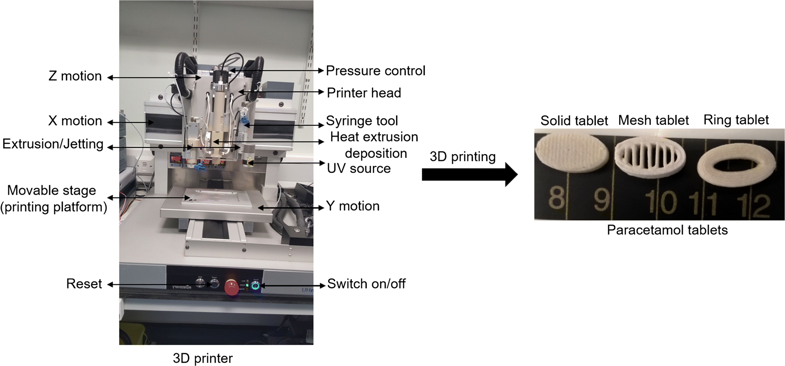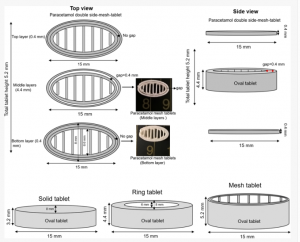 Yissum, which is the Hebrew University of Jerusalem‘s technology transfer company and handles the patenting and commercialization of any inventions produced there, has had a hand in many unique 3D printing innovations, such as Nano Dimension’s conductive nano-inks and a process to generate hybrid machine elements. Last year, the company, which was founded in 1964 and has licensed over 900 technologies and registered over 10,000 patents covering 2,800 inventions, introduced a novel technology platform for 3D printing personalized food, and has now moved on to 3D printing personalized medicine.
Yissum, which is the Hebrew University of Jerusalem‘s technology transfer company and handles the patenting and commercialization of any inventions produced there, has had a hand in many unique 3D printing innovations, such as Nano Dimension’s conductive nano-inks and a process to generate hybrid machine elements. Last year, the company, which was founded in 1964 and has licensed over 900 technologies and registered over 10,000 patents covering 2,800 inventions, introduced a novel technology platform for 3D printing personalized food, and has now moved on to 3D printing personalized medicine.
The company, which is only the third of its kind, builds a bridge between academic research and its worldwide community of entrepreneurs, investors, and industry. It’s responsible for spinning more than 135 total companies. Yissum recently announced a novel technology platform for fabricating 3D printed drug capsules, and presented it today at the university’s 2nd annual 3D Printing and Beyond conference, which is sponsored by Yissum, the university, and the Jerusalem Development Authority.
 Professor Shlomo Magdassi, head of the university’s 3D and Functional Printing Center and a member of the Center for Nanoscience and Nanotechnology and Institute of Chemistry, worked with Dr. Ofra Benny, a researcher at the university’s Institute for Drug Research, to develop the innovative drug 3D printing technology platform.
Professor Shlomo Magdassi, head of the university’s 3D and Functional Printing Center and a member of the Center for Nanoscience and Nanotechnology and Institute of Chemistry, worked with Dr. Ofra Benny, a researcher at the university’s Institute for Drug Research, to develop the innovative drug 3D printing technology platform.
“Professor Magdassi and Dr. Benny’s research is an excellent example of the kind of interdisciplinary transformational inventions that originate from the Hebrew University,” said Dr. Yaron Daniely, CEO and President of Yissum. “This technology is bringing us closer to a future in which the medical field can offer personalized, patient-centered care.”
 The technology is based on custom 3D printed hydrogels with delayed release characteristics, and allows for a complex design of drug delivery systems that is not currently available in the more traditional pharmaceutical manufacturing techniques.
The technology is based on custom 3D printed hydrogels with delayed release characteristics, and allows for a complex design of drug delivery systems that is not currently available in the more traditional pharmaceutical manufacturing techniques.
Dr. Magdassi already has plenty of experience with 3D printed hydrogels and other unique 3D printable materials. 3D hydrogels are hydrophilic polymeric networks that are cross-linked by either chemical covalent bonds, physical interactions, or a combination. Because of these crosslinks between polymer chains and their hydrophilic nature, hydrogels can actually swell up to a hundred times, or even a thousand, of their dried mass without needing to be dissolved in water, and they are an ideal material for biomedical applications.
Yissum’s company mission is to take transformational technologies and innovations and convert them into commercial solutions that address the most urgent challenges in our world, in order to benefit society. I’d say this new 3D printing platform fits the bill – the approach makes it possible to 3D print customized medications out of hydrogel objects that can change shape, expand, and even activate on a delayed schedule.
The novel new 3D printing platform can not only achieve complex release profiles and structures of drugs, but it can also personalize prescription medicines, so doctors can more accurately tailor the dosage levels and exposure of medications for different patients. Thanks to 3D printing, medication may not have to be one-size-fits-all.
Professor Magdassi and Dr. Benny presented their work at the 3D Printing and Beyond conference today, which Professor Magdassi helps organize with Dr. Michael Layani. The conference brings together a range of researchers and industry leaders from around the world to discuss and learn more about the latest advances in defense-related technologies, electronics, and pharmaceuticals, in addition to 3D printed innovations like automotive parts and food.
Discuss this story and other 3D printing topics at 3DPrintBoard.com or share your thoughts in the Facebook comments below.




